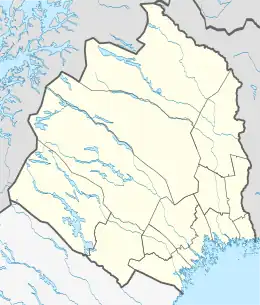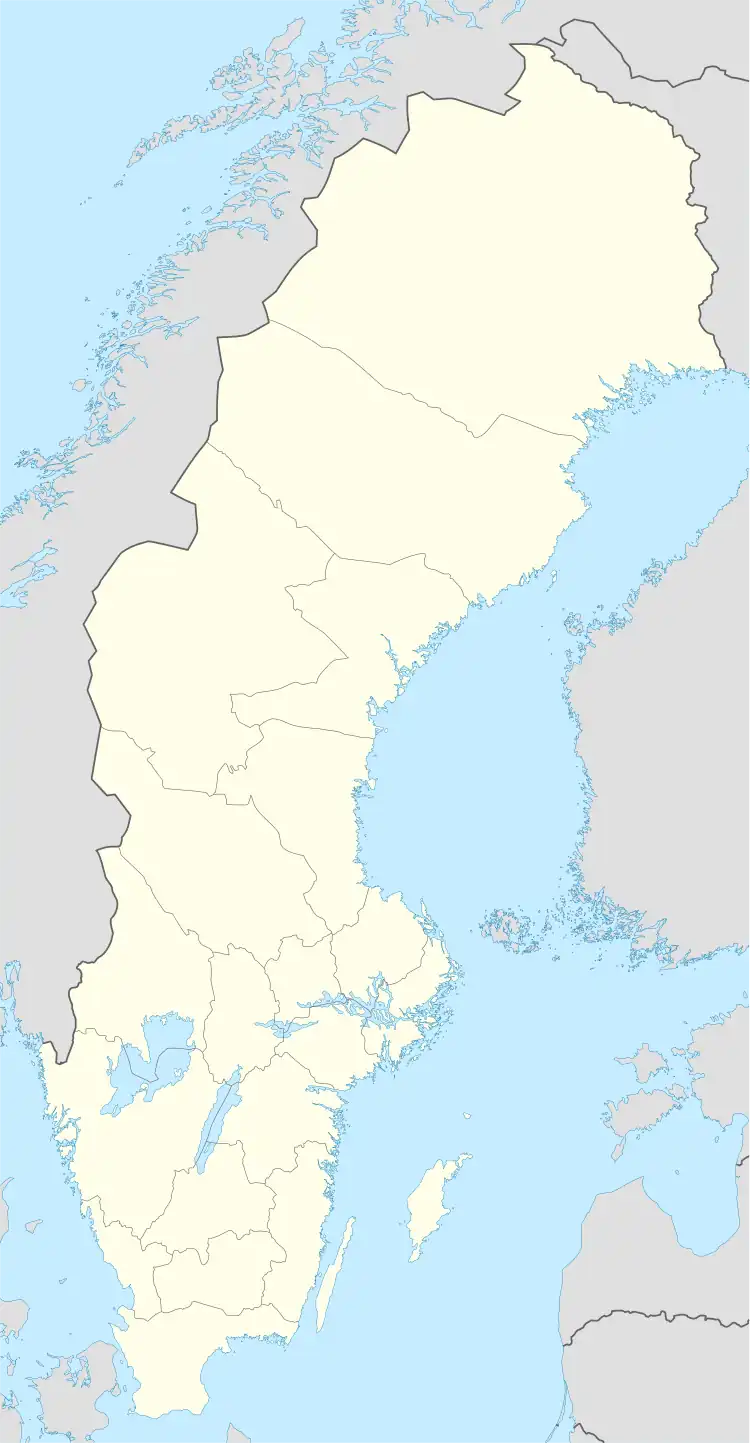Gällivare | |
|---|---|
 The main street (Storgatan) with snow and Christmas lights in Gällivare at about noon in December 2005. | |
 Gällivare  Gällivare | |
| Coordinates: 67°07′48″N 20°39′36″E / 67.130°N 20.66°E | |
| Country | Sweden |
| Province | Lapland |
| County | Norrbotten County |
| Municipality | Gällivare Municipality |
| Area | |
| • Total | 7.48 km2 (2.89 sq mi) |
| Population (31 December 2010)[1] | |
| • Total | 8,449 |
| • Density | 1,130/km2 (2,900/sq mi) |
| Time zone | UTC+1 (CET) |
| • Summer (DST) | UTC+2 (CEST) |
Gällivare (Swedish pronunciation: [ˈjɛ̌lːɪvɑːrɛ];[2] Finnish: Jällivaara; Northern Sami: Jiellevárri or Váhčir; Lule Sami: Jiellevárre or Váhtjer; Meänkieli: Jellivaara) is a locality and the seat of Gällivare Municipality in Norrbotten County, province of Lapland, Sweden with 8,449 inhabitants in 2010.[1] The town was founded in the 17th century. Together with nearby towns Malmberget and Koskullskulle it forms a conurbation with some 15,000 inhabitants. This conurbation is the second northernmost significant urban area of Sweden after Kiruna.
Gällivare is situated at the northern end of the Inlandsbanan railway line, about 100 kilometres north of the Arctic Circle. Gällivare is located in a major iron ore mining region. Adjacent to Gällivare (about five kilometres) is Malmberget, known as a site for iron ore extraction from deep mines by LKAB.
Outside Gällivare lies the ski resort Dundret, which is equipped with six ski lifts and ten groomed slopes along with a conference center and hotel. The ski season stretches from the end of October all the way into early May. The town has been host for several World Cup skiing events, both alpine and cross-country.
Gällivare is the center of the Firstborn Laestadian movement.
It was the host town for the 2008 VIVA World Cup and also the filming spot for Avicii's single "Addicted to You". Sweden's second-largest fast food chain, Max Hamburgers, was founded in Gällivare, though the headquarters have since relocated to Luleå.
Climate
As expected given its high latitude, Gällivare has a rather cold climate. Under the Köppen climate classification it is a subarctic climate (Dfc). Winters are very severe by Scandinavian standards, but are somewhat moderated by marine air from the North Atlantic. As a result, certain cities on the North American Great Plains such as Winnipeg and Grand Forks, along with East Asian cities even further south, have colder January averages than Gällivare. The winter temperature varies greatly due to the city's location between the open ocean and a large, snow-covered land mass, and can be −30 °C (−22 °F) one day to 0 °C (32 °F) the next.
Gällivare experiences midnight sun for a significant period of summer, though sees some glimpses of daylight even during the winter solstice due to its notable distance from the Arctic Circle. As a result of prolonged warming from early morning by the midnight sun and Gällivare's inland position, temperatures can occasionally get hot in the summer. The all-time high stands at 34.5 °C (94.1 °F).
| Climate data for Gällivare (averages 2002–2018; extremes since 1901) | |||||||||||||
|---|---|---|---|---|---|---|---|---|---|---|---|---|---|
| Month | Jan | Feb | Mar | Apr | May | Jun | Jul | Aug | Sep | Oct | Nov | Dec | Year |
| Record high °C (°F) | 7.6 (45.7) |
7.5 (45.5) |
12.5 (54.5) |
19.0 (66.2) |
28.2 (82.8) |
30.6 (87.1) |
34.5 (94.1) |
31.4 (88.5) |
24.1 (75.4) |
16.7 (62.1) |
9.6 (49.3) |
8.0 (46.4) |
34.5 (94.1) |
| Mean maximum °C (°F) | 1.8 (35.2) |
3.3 (37.9) |
5.9 (42.6) |
11.9 (53.4) |
21.2 (70.2) |
24.5 (76.1) |
25.7 (78.3) |
24.5 (76.1) |
19.2 (66.6) |
11.2 (52.2) |
4.6 (40.3) |
3.4 (38.1) |
27.1 (80.8) |
| Mean daily maximum °C (°F) | −8.2 (17.2) |
−6.6 (20.1) |
−1.3 (29.7) |
4.5 (40.1) |
11.1 (52.0) |
16.2 (61.2) |
20.1 (68.2) |
17.3 (63.1) |
11.6 (52.9) |
3.4 (38.1) |
−2.7 (27.1) |
−5.5 (22.1) |
5.0 (41.0) |
| Daily mean °C (°F) | −13.1 (8.4) |
−11.9 (10.6) |
−6.9 (19.6) |
−0.5 (31.1) |
5.9 (42.6) |
11.0 (51.8) |
14.7 (58.5) |
12.2 (54.0) |
7.2 (45.0) |
0.1 (32.2) |
−6.9 (19.6) |
−10.2 (13.6) |
0.1 (32.3) |
| Mean daily minimum °C (°F) | −18.0 (−0.4) |
−17.1 (1.2) |
−12.5 (9.5) |
−5.4 (22.3) |
0.7 (33.3) |
5.7 (42.3) |
9.2 (48.6) |
7.0 (44.6) |
2.7 (36.9) |
−3.3 (26.1) |
−11.0 (12.2) |
−14.9 (5.2) |
−4.7 (23.5) |
| Mean minimum °C (°F) | −31.8 (−25.2) |
−31.4 (−24.5) |
−26.5 (−15.7) |
−17.8 (0.0) |
−6.5 (20.3) |
−1.2 (29.8) |
2.7 (36.9) |
−0.3 (31.5) |
−4.2 (24.4) |
−14.6 (5.7) |
−24.1 (−11.4) |
−28.5 (−19.3) |
−34.9 (−30.8) |
| Record low °C (°F) | −43.3 (−45.9) |
−40.0 (−40.0) |
−36.5 (−33.7) |
−33.5 (−28.3) |
−20.0 (−4.0) |
−6.0 (21.2) |
0.0 (32.0) |
−4.0 (24.8) |
−10.3 (13.5) |
−24.0 (−11.2) |
−33.5 (−28.3) |
−39.1 (−38.4) |
−43.3 (−45.9) |
| Average precipitation mm (inches) | 40.8 (1.61) |
32.6 (1.28) |
21.9 (0.86) |
26.9 (1.06) |
50.3 (1.98) |
65.7 (2.59) |
97.8 (3.85) |
76.0 (2.99) |
69.2 (2.72) |
42.8 (1.69) |
49.9 (1.96) |
48.4 (1.91) |
622.3 (24.5) |
| Source 1: SMHI Open Data[3] | |||||||||||||
| Source 2: SMHI climate data 2002–2018[4] | |||||||||||||
High incidence of congenital insensitivity to pain
Some inhabitants near Gällivare, mainly in the village of Tjautjas (also Tjautjasjaure or Čavččas) 20 km outside Gällivare, have a remarkably high incidence of congenital insensitivity to pain, an extremely rare disease which inhibits the sensation of pain, heat and cold. There have been nearly 40 reported cases in the area.[5]
Sports
The following sports clubs are located in Gällivare:
References
- 1 2 3 "Tätorternas landareal, folkmängd och invånare per km2 2005 och 2010" (in Swedish). Statistics Sweden. 14 December 2011. Archived from the original on 27 January 2012. Retrieved 10 January 2012.
- ↑ Sahlgren, Jöran; Bergman, Gösta (1979). Svenska ortnamn med uttalsuppgifter (in Swedish). p. 10.
- ↑ "SMHI Öppen Data för Gällivare A" (in Swedish). Swedish Meteorological and Hydrological Institute.
- ↑ "Yearly & Monthly statistics" (in Swedish). SMHI. 23 June 2019. Archived from the original on 2 May 2019. Retrieved 9 March 2016.
- ↑ Minde J (2006). "Norrbottnian congenital insensitivity to pain". Acta Orthopaedica Supplementum. 77 (321): 2–32. PMID 16768023.